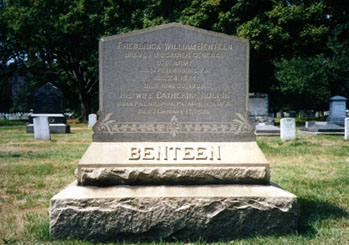|
|
 |
|
|
|
 |
|
| On August 24, 1834 in Petersburg, Virginia, Fredrick William Benteen was born. Benteen and his family were from the south but Benteen dreamed of being a Union General. Benteen's dream came true, He was part of the Union army. He was enlisted in the Tenth Missouri Cavalry as a lieutenant. During the Civil War, Benteen moved rapidly through the ranks, and took control of several regiments. In 1862 Benteen married his longtime girlfriend Kate Norman. Benteen and his wife bought a house outside Southern Atlanta. After they settled down, Fredrick went back to his regiment in the army. | |
| In 1864 Benteen took over the 138th U.S. Colored Volunteers. A copal days later Benteen resigned from the 10th Missouri Cavalry. But in 1866 the 138th USCT disbanded and Fredrick was out of the job. On July 28, 1867 the Army Act was passed and 30 new regiments, and 4 new cavalries were formed. The cavalries were, the 9th and 10th, which were the colored units, and the 7th and 8th, which were the white units. Benteen September, applied for the Regular Army commission in the 7th or 8th cavalry. On November 24, Benteen accepted to be a Captain in the 7th cavalry. He was ordered to Fort Riley, Kansas to depart with the new assignment with the 7th cavalry. That's when he met the famous George Armstrong Custer. When he first saw Custer he knew he would dislike him. |
|
|
On November 27, 1868, at the Battle of Washita, Benteen's dislike of
Custer changed to pure hatred. Benteen hated Custer now because troops
led by Major Elliott had left the 7th cavalry and went looking for a
band of escaping Indians. At the end of the day Major Elliott had not
came back. Custer ordered the troops to go back to the supply
station without looking for Major Elliott. But on December 2, Custer had
to report to General Sheridan about the Battle of Washita. Custer lied
to Sheridan about the lost soldiers. After that Benteen barged in and
told the truth that he didn't make any attempt to find the soldiers. But
that wouldn't be the last of the arguments.
|
|
|
At the Battle of Little Big Horn, Benteen and Custer argued over the
plan to attack the Indians. Custer told the troops to break up in three
groups and surround the village. Benteen disagreed. He thought that they
should wait for the other troops coming to relieve the 7th Cavalry.
Custer didn't listen, He kept on ignoring them.
|
|
|
On the day of the day of the Battle of Little Big Horn, Custer ordered
the troops to charge the village. Benteen was ordered to charge the
south fork of the river. That was where Benteen retreated. After the
retreat, Benteen joined with Major Reno in a plan to survive. The 7th
Cavalry wasn't destroyed. Reno, Benteen, and about 400 soldiers survived
the two-day battle at the hill four miles away from the place where
Custer died.
|
|
|
After the Battle of Little Big Horn, Benteen moved to the 9th Cavalry
were he stayed until his retirement. But in 1879, in Chicago, Benteen
and Reno were ordered to testify in front of the jury. They presented a
forged petition and altered maps for the cover-up.
|
|
| On Wednesday, June 22,1898, Benteen died. At the funeral were a lot of people. The Governor of Georgia, the Mayor of Atlanta, and several other important people. |  |
| Richard Flach
8th Grade Rossville Jr. High 2001 American History |
|
|